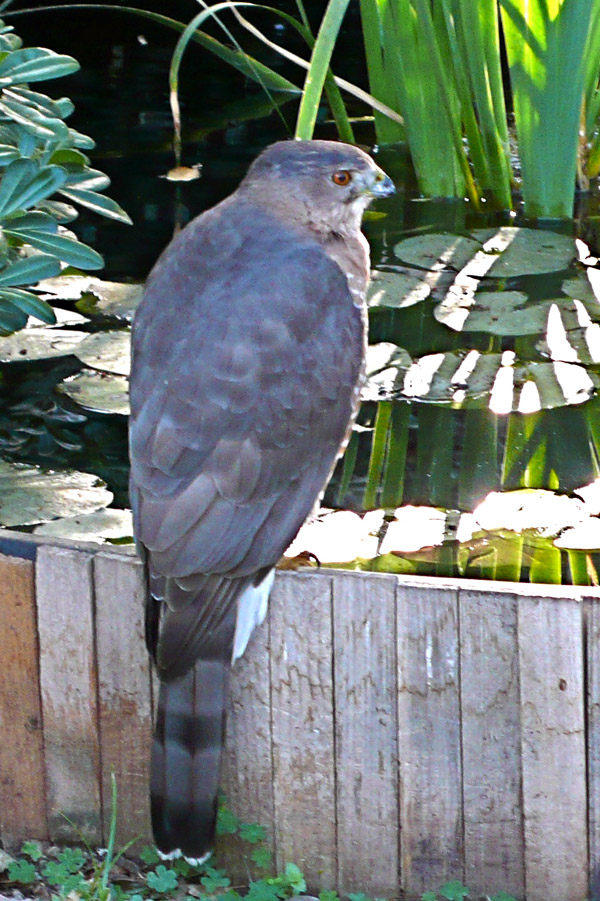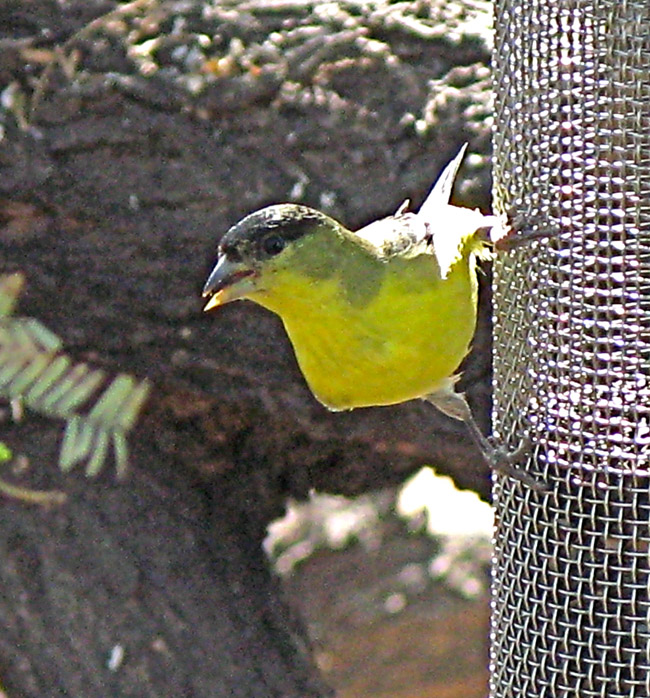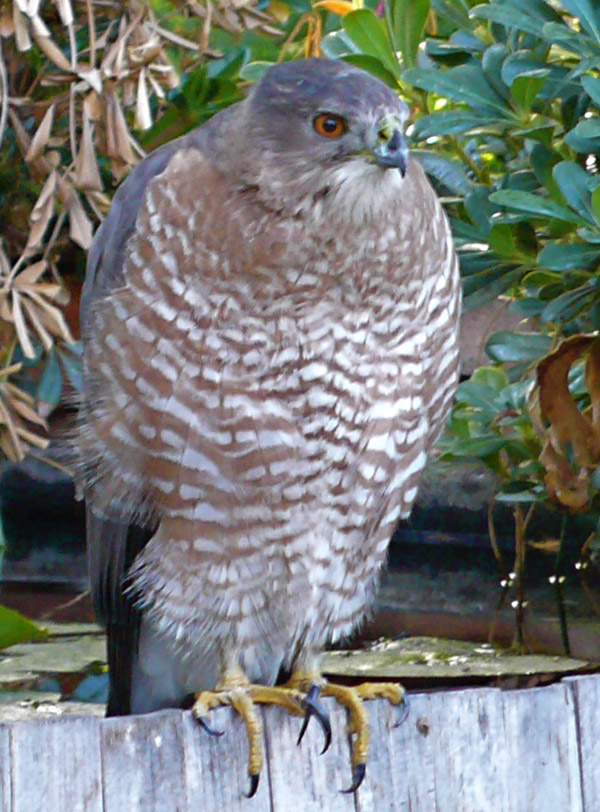A close brush with a hunter
Weeks out of “swim-season”, our pool is a bit dishevelled right now: a recent windstorm, a bit of a chemical imbalance, a bit of neglect, made it time to brush the pool.  It’s a task that in itself isn’t huge fun in cold weather — cold wet aluminum chills the paws fast! — but does get me out of the studio into the outdoors.
It’s a task that in itself isn’t huge fun in cold weather — cold wet aluminum chills the paws fast! — but does get me out of the studio into the outdoors.
It was nice to be out this morning. Our post-rainstorm air was still clear as blue glass, the temp in the low forties (yes, snow-dwellers, I know this isn’t actually cold!). The bird feeders, seed-feeders and nectar-feeders both, were crowded with fressing finches and zizzing hummers, and the squee-like contact calls and chatter of the busy Lesser goldfinches filled the yard.
(left: adult Cooper’s hawk. Photo by Hanna Breetz)
Suddenly, a gray blur shot low over my right shoulder, and streaked over the pool to where the birds filled the creosote bushes, waiting for their turn at nyjer thistle and oilers, or warming in the early sunlight. The blur pulled up as the finches and sparrows scattered, and manifested as an adult Cooper’s hawk, probably a female to judge by her size (female hawks are generally larger than their males). A couple of passes through the mesquite tree and she’d emptied the place of smaller birds: Inca doves, goldfinch, house finch, thrashers, Abert’s towhees, cactus wrens, and white-throated sparrows, even the mourning doves  and Gambel’s quail, all exploded off the ground, out of the trees and bushes, off the feeders, and disappeared over the yard walls with a burst of wing percussion, jibbering and complaining. Hummers scolded energetically from their perches safe inside the thorny citrus.
and Gambel’s quail, all exploded off the ground, out of the trees and bushes, off the feeders, and disappeared over the yard walls with a burst of wing percussion, jibbering and complaining. Hummers scolded energetically from their perches safe inside the thorny citrus.
(right: “accipiter kibble”; if you put out seed for the finches, you’re also putting out finches for the raptors. This is a Lesser goldfinch hang-feeding on a thistle-feeder. Photo A.Shock)
The hawk paused on the top of the wall, searching the creosote below her with a fierce red gaze, glaring a few more birds out from the thin cover. Then she flew off, empty-taloned, around the corner of the house, possibly headed for the crowded seed feeders in the front yard.
Cooper’s hawks (Accipiter cooperi) are spry-flighted bird specialists, adept at tail-chasing winged prey through foliage or over open terrain due to their short wings and long tails. These traits show excellently on the photo at the top of the page, a bird perched on a water feature in my friend Hanna’s Phoenix yard last November. In the photo to the left, take a look at those long yellow toes, and sharp, curved talons: more bird-catching equipment.
through foliage or over open terrain due to their short wings and long tails. These traits show excellently on the photo at the top of the page, a bird perched on a water feature in my friend Hanna’s Phoenix yard last November. In the photo to the left, take a look at those long yellow toes, and sharp, curved talons: more bird-catching equipment.
(left: the same Cooper’s hawk as above, showing delightfully rusty-barred breast, and intense red iris. Photo by Hanna Breetz.)
I finished brushing the pool, but in the silence of a yard emptied of small yammering finches and bossy cactus wrens. Warming my hands on my coffee cup, I hope the Coop’s finds a fat hot pigeon to take off the morning chill.
(Guest photographer Hanna Breetz often has knitting needles as well as a camera in her hands: you can read her green knitting blog, Ever Green Knits, here.)
BTW, just had another bird moment in a humble locale: While in the looney-bin that passes for a local strip mall parking lot, I looked up to see a heavy-bodied, dark falcon laboring aloft with prey, headed for a high rung of an enormous antenna that looms over this block of big box stores deep in east Phoenix. Seeing a Peregrine in a place like this is not only a bit of happy spotting, but a great reminder to keep your eyes open: spot opportunities anywhere, like a hawk.

Thanks for the great photos of the Cooper’s Hawk, Allison, since the only one I’ve seen was pretty much hidden in the branches of the tree in which he or she was perched in Tucson a few weeks ago. Those talons are eerily fascinating, it’s unfortunate they are such a formidable threat to the smaller birds we love so well. I spotted a hawk (which I am assuming was one of the red-tailed variety) last weekend seated on a large road sign and didn’t have time as I sailed by at 100 km/hr to look at it closely (since I was alone and behind the wheel!) but you’re right, the opportunity to spot can happen at any time and is always enjoyable even if the glimpse is fleeting or obscured.
Well, of course, Hanna is the photog responsible for the great Cooper’s hawk photos — what an amazing thing to go out into your backyard, and see one perched so close! An immature Cooper’s hawk, with its brown, vertically streaked breast, is shown in this post, but from a much more distant vantage point: http://threestarowl.com/natural-history/a-first-year-coopers-hawk